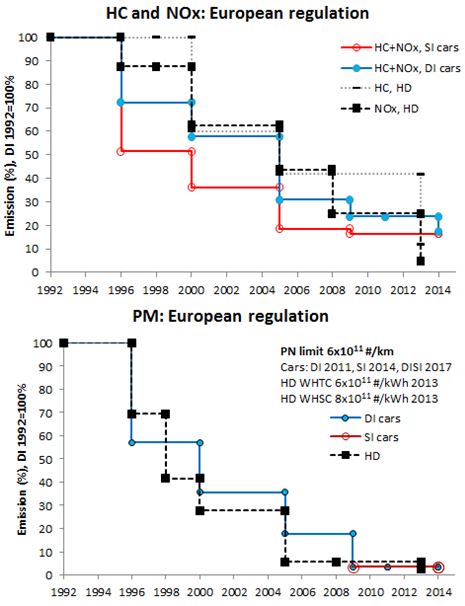Emission regulations
CO, THC, NOx and PM emissions from transport applications are typically limited by legislation. In addition to these “regulated” emission species, the following emission regulations are implemented:
- In addition to the mass-based PM limits, a limit to solid particulate number emissions (SPN) was introduced in 2011 for diesel engines (Euro 5b) and in 2014 for petrol engines (Euro 6).
- An NH3 concentration limit of 10 ppm applies in Europe to Euro VI diesel and gas engines, but not to cars.
- Formaldehyde emissions are regulated in the US.
- Greenhouse gas emissions are regulated in the US.
- NO2 is limited for retrofitted heavy-duty engines in the US.
- Sulphur oxide (SOx) emissions are limited through regulations on the sulphur content of fuel. For example, sulphur content of diesel fuel and gasoline is limited to 10 mg/kg in Europe and to 15 mg/kg in the U.S.
The most stringent emission regulations are implemented in California, such as LEV III emission categories in Table 1. Formaldehyde emission from cars has been regulated in the United States for decades.
Table 1. LEV III emission standards in California phased-in over the 2015-2025 (FTP-75 test). Durability 150,000 miles, FTP-75. (www.dieselnet.com 5.7.2016).
|
NMOG a +NOx g/mi |
CO |
HCHO mg/mi |
PM b |
||
|
Passenger cars |
0.160 |
4.2 |
4 |
0.01 |
|
|
LEV160 |
0.160 |
4.2 |
4 |
0.01 |
|
|
ULEV125 |
0.125 |
2.1 |
4 |
0.01 |
|
|
ULEV70 |
0.070 |
1.7 |
4 |
0.01 |
|
|
ULEV50 |
0.050 |
1.7 |
4 |
0.01 |
|
|
SULEV30 |
0.030 |
1.0 |
4 |
0.01 |
|
|
SULEV20 |
0.020 |
1.0 |
4 |
0.01 |
a Non-methane organic gases b PM standards will be tightened to 3 mg/mi with phase-in from 2017 to 2021.
The United States has limits for greenhouse gas emissions (Table 2). The CO2-equivalent in this rule is calculated by using CO2 equivalence factors of 298 for N2O and of 25 for CH4. In addition, the rule includes limits for tailpipe N2O and CH4 emissions to prevent increase in these emissions in the future vehicles (www.dieselnet.com 5.7.2016):
- N2O: 0.010 g/mile
- CH4: 0.030 g/mile
Table 2. Projected 2012-2016 Fleet-Wide CO2 and Fuel Economy Compliance Levels in the US. (www.dieselnet.com 5.7.2016).
|
Model Year |
||||||
|
2012 |
2013 |
2014 |
2015 |
2016 |
||
|
Passenger cars |
CO2, g/mi |
263 |
256 |
247 |
236 |
225 |
|
CO2 equiv. mpg a |
33.8 |
34.7 |
36.0 |
37.7 |
39.5 |
|
|
CAFE mpg |
33.3 |
34.2 |
34.9 |
36.2 |
37.8 |
|
a In the CO2-equivalent standard, the N2O and CH4 emissions are added to the CO2 emissions using a CO2 equivalence factor of 298 for N2O and of 25 for CH4.
Regulations on the exhaust emissions are in some respects less demanding in Europe than in the US. In Europe, greenhouse gases are not regulated, while targets for CO2 emissions are defined. Progress of the NOx standards have been slower in Europe than in the US leading to high levels of NO2 in urban areas in Europe. The EURO 6/VI regulations are expected to alleviate this situation by wider use of the SCR technology (Health Effects Institute 2015). Limits for formaldehyde, N2O or CH4 emissions are not implemented in Europe, while they are limited in the US. On the other hand, PN limit is not included in the US regulation, while it is in place in Europe. PN limit in Europe takes into account only solid particles (SPN), while health effects are assumedly related in total particles (wet-PN). Development of the regulated emissions in Europe over the past decades is shown in Figure 1. HC and NOx emissions are below 20%, PM emissions below 10% and CO emissions below 40 of the level of 1992.

Figure 1. Schematic figure of tightening emission regulations in Europe.


